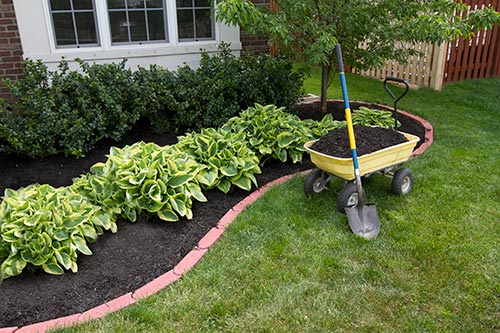A healthy and well-maintained residential garden can improve the appearance and atmosphere of a home. To keep a residential garden looking fresh and aesthetically pleasing, you can plant flowers, fruits, vegetables, trees and other vegetation, and you can spread different colors and sizes of mulch.
Natural mulch is made from shredded bark, wood chips, peat, plant fibers, micronutrients and other materials. Mulch is often mixed with topsoil, compost and plant food to nourish plants and trees. High-quality mulch will keep the garden soil moist around trees and plants, keep the soil temperature consistent, discourage weeds and prevent soil erosion.
Here are some ways to use different mulches in a residential garden.

Sculptured Garden Beds
Ground-level garden beds that border a house, trees and garden beds can be topped with different mulches to keep the soil in the beds moist but not wet. Once you have defined these areas, spread 3 to 4 inches of mulch on top of the soil.
Keep mulch about 1 – 3 inches from the stems of growing plants and 3 – 5 feet from the base of tree trunks. When irrigating your garden, water the plants and trees as well as the surrounding mulch and allow the irrigation water to drain through the mulch into the ground to feed the underground root systems.
Raised Garden Beds
Raised garden beds can be created by installing large wooden planter boxes in your yard. When installing a wooden planter box, first drill holes in the bottom of the box and line it with rocks and stones to facilitate drainage. Elevate all wooden planter boxes off the ground with bricks or flagstone to keep the bottom of the wooden box from disintegrating from water rot.
Fill the garden box with potting soil to a height that is about 6 inches from the top of the box. Plant the garden box with a variety plants and feed and water them. Spread a 3- to 4-inch layer of mulch on top of the soil around the plants to keep them moist and free of weeds.
Changeable Garden Containers
To have blooming plants in your garden during all seasons of the year, plant potted annual plants and change them as the seasons change. To do this easily, buy several round 15-gallon to 20-gallon plastic or rubber nursery greenhouse containers.
Dig a trench that is as deep as the height of the greenhouse containers and place the containers in the trench. Fill the area around each of the containers with mulch to the top of the container. Fill the bottom of each nursery container with rocks for drainage.
Place one potted plant in each container and fill the area around the plant with mulch. When you wish to change a growing plant, pull out the potted plant that you wish to remove and replace it with a new one.
Mulched Landscapes
Mulch can be used to cover garden paths, patios, barbecue areas, play yards and other areas. Landscape mulch is easy to walk on and drains well when wet from garden irrigation or rain.
Landscape mulch is available in the following colors to distinguish separate areas of your yard: black, dark brown, golden yellow, brick red and medium brown. Landscape mulch is also available in various sizes to further differentiate areas of your yard.
To have a beautiful residential garden, research and grow the plants and trees that are native to your location. Water and feed them as recommended for each species and change your potted plants as needed. Refresh your garden beds and landscaped areas with new mulch in different colors and sizes for each area of your residential yard.
Contact Parker Bark Company, Inc. for high-quality mulches, topsoils, soil mixes and soil conditioners. We have the products and experience to help you create and maintain a healthy and vibrant garden.


